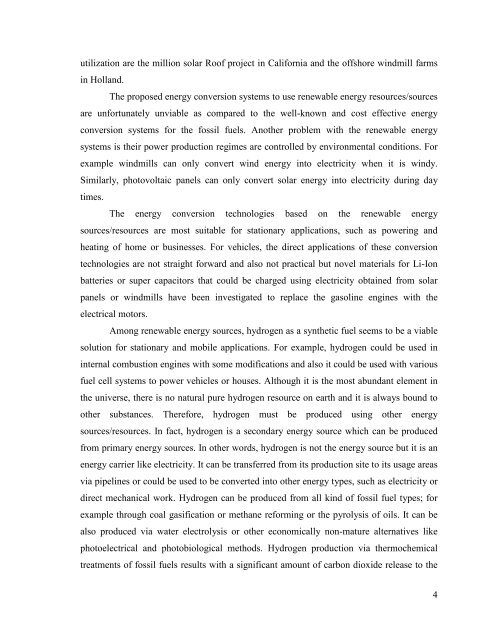hydrogen production from water using solar cells powered nafion ...
hydrogen production from water using solar cells powered nafion ...
hydrogen production from water using solar cells powered nafion ...
Create successful ePaper yourself
Turn your PDF publications into a flip-book with our unique Google optimized e-Paper software.
utilization are the million <strong>solar</strong> Roof project in California and the offshore windmill farms<br />
in Holland.<br />
The proposed energy conversion systems to use renewable energy resources/sources<br />
are unfortunately unviable as compared to the well-known and cost effective energy<br />
conversion systems for the fossil fuels. Another problem with the renewable energy<br />
systems is their power <strong>production</strong> regimes are controlled by environmental conditions. For<br />
example windmills can only convert wind energy into electricity when it is windy.<br />
Similarly, photovoltaic panels can only convert <strong>solar</strong> energy into electricity during day<br />
times.<br />
The energy conversion technologies based on the renewable energy<br />
sources/resources are most suitable for stationary applications, such as powering and<br />
heating of home or businesses. For vehicles, the direct applications of these conversion<br />
technologies are not straight forward and also not practical but novel materials for Li-Ion<br />
batteries or super capacitors that could be charged <strong>using</strong> electricity obtained <strong>from</strong> <strong>solar</strong><br />
panels or windmills have been investigated to replace the gasoline engines with the<br />
electrical motors.<br />
Among renewable energy sources, <strong>hydrogen</strong> as a synthetic fuel seems to be a viable<br />
solution for stationary and mobile applications. For example, <strong>hydrogen</strong> could be used in<br />
internal combustion engines with some modifications and also it could be used with various<br />
fuel cell systems to power vehicles or houses. Although it is the most abundant element in<br />
the universe, there is no natural pure <strong>hydrogen</strong> resource on earth and it is always bound to<br />
other substances. Therefore, <strong>hydrogen</strong> must be produced <strong>using</strong> other energy<br />
sources/resources. In fact, <strong>hydrogen</strong> is a secondary energy source which can be produced<br />
<strong>from</strong> primary energy sources. In other words, <strong>hydrogen</strong> is not the energy source but it is an<br />
energy carrier like electricity. It can be transferred <strong>from</strong> its <strong>production</strong> site to its usage areas<br />
via pipelines or could be used to be converted into other energy types, such as electricity or<br />
direct mechanical work. Hydrogen can be produced <strong>from</strong> all kind of fossil fuel types; for<br />
example through coal gasification or methane reforming or the pyrolysis of oils. It can be<br />
also produced via <strong>water</strong> electrolysis or other economically non-mature alternatives like<br />
photoelectrical and photobiological methods. Hydrogen <strong>production</strong> via thermochemical<br />
treatments of fossil fuels results with a significant amount of carbon dioxide release to the<br />
4

















